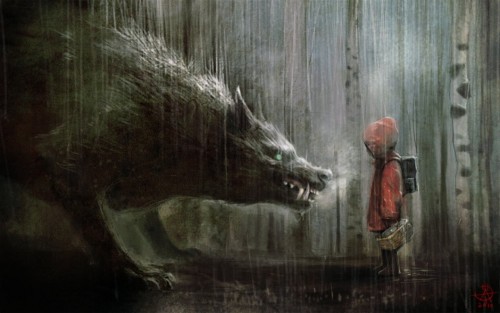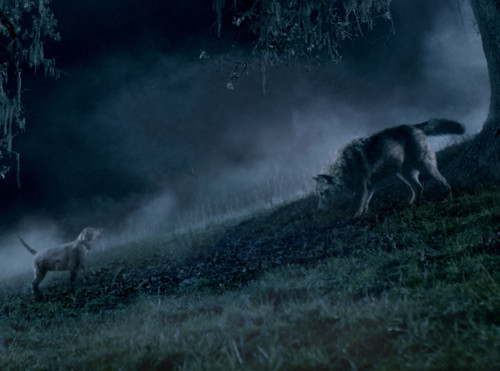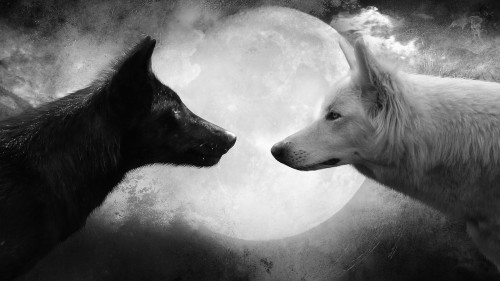Howling to be Heard: Wolf Folklore

“My grandmother what big teeth you have.”
“The better to eat you with, my dear!”
Myths and legends, both positive and negative, have surrounded the wolf for centuries. This is without a doubt where many of our opinions and general notions of wolves originated. Most cultures throughout history have held the wolf as a revered, distinguished animal. In fact, most Native American tribes saw the wolf as an animal closely related to humans and a carrier of strong medicine. Native Americans viewed the wolf as courageous, strong, loyal, and a successful hunter. Even some of our Northwestern tribes such as the Quileute and Kwakiutl included the wolf in their stories of origin where their first ancestors were transformed from wolves into men. European history and mythology, which has its origins in Rome, also has a positive connotation of the wolf. Many people are familiar with the story of how Romulus and Remus, sons of the war god Ares, came to found the city of Rome after being orphaned and raised by a female wolf.
Why then has the wolf been portrayed in such a negative light for past several centuries? Why is an animal that was so revered in indigenous cultures put on trial in a quick turn of events? Why do we never hear these stories with the wolf as the hero? To answer these questions we must look at the time period in which these negative myths and legends began to surface. It was during the Middle Ages when Europeans started moving out into the countryside to raise crops and domesticate animals.
The first image most people today have of the wolf is from the fairy tale Little Red Riding Hood, where a wolf cunningly disguises itself in order to eat a helpless little girl. The wolf is then killed by the heroic hunter who slices open the wolf’s belly, saving Little Red Riding Hood. In our western society we have created an image of the wolf as an evil, bloodthirsty and voracious killer. In Norse Mythology, the god Odin had two wolves named Geri and Freki, both meaning “the ravenous” or “greedy one.” But where and how did these stories enter into our culture? For the answer, let’s take a trip back in time to the Middle Ages: a time when the human species started cultivating crops and raising domestic livestock; a time when the Catholic Church exerted the greatest influence on how people thought and acted.
As man entered into a new age, a new way of thinking and living emerged. Civilization and cultivated land became the norm and way of Christian living. Man began demonstrating dominance over the natural world by clearing the forest, cultivating the land, and raising domestic livestock. It was thought that it was God’s will for man to have dominion over all the earth and anything that stood in the way of that was evil. If something went awry, humans needed some sort of scapegoat for their own faults and shortcomings. They quickly turned to an animal that was highly intelligent, shared the same social structure, and hunted as humans did. An animal living in close proximity to them that remained wild and untamed: the wolf.
As Europeans moved into the countryside a new word emerged, a word with evil connotations, a word that represented a place where the devil dwelt and witches performed satanic rituals. This word was wilderness. According to Roderick Nash the word “wilderness” emerged from the old Teutonic and Norse languages. It combined the word will, or willd, meaning self-willed or uncontrollable, and the word deor that was an Old English word for an animal (this is where the modern word deer most likely originated from). As domestic animals, controlled by man, were beginning to thrive, self-willed animals or the will-deor started to take on a negative public image. And wild-deor-ness became a word to mean a place of self-willed animals where man did not have control. At this same time the Catholic Church claimed that it was man’s obligation to control the entire earth. One can see how in the Middle Ages, when humans’ self will was tied so closely to God and salvation and the soul, that a place of wild animals became a place associated with evil. The animal most closely associated with this new word “wilderness” was the wolf.
As domesticated animals became the norm, and the number of cattle and sheep began to rise, and forests continued to be cultivated, man became more and more distanced from the natural world. But occasionally a wild animal, with its only thought being survival and feeding its family, would wander into a field of sheep. As forests were converted to farmland, deer habitat and other ungulate (hoofed animals) habitat decreased and resulted in a limited supply of food for predators. Most of us have seen movies of a post-apocalyptic world where our civilization has been destroyed and resources are hard to come by. Now imagine if humans were in that world and we came across a lair stocked full of apples, fresh vegetables, and canned meats. Would we take it?
Now imagine the forests, the equivalent of our civilization for wild animals, rapidly deteriorating and the food stock reduced drastically. A wolf wanders out of its forested civilization, starving because there are no deer left, and wanders into a field full of domesticated ungulates. Will it enjoy an easy meal or simply walk away out of respect for the humans who decimated most of their food sources and destroyed most of their habitat? Enter the big bad wolf. Humans now had the perfect symbol of evil: a bloodthirsty, ravenous creature that posed a threat to human progress and happiness, and therefore God.
The wolf was a wolf no longer, but a satanic creature. It was a self-willed animal that entered farmers’ fields at night and destroyed livestock, savagely killing sheep and cattle. It is only natural that when man began cultivating forests and putting livestock on the wolf’s hunting grounds, their habitat started to diminish. Livestock represented a free meal in a shrinking habitat with a diminishing deer herd. Wolves prevented the progress of civilization, which in the Middle Ages was the expansion of the Catholic Church. The wolf became a scapegoat and in Middle Age Europe their extermination became a priority. Wolf: public enemy number one.
Stories and myths began popping up left and right with the wolf always portrayed as the antagonist. Little Red Riding Hood, The Boy Who Cried Wolf, and The Three Little Pigs are just a few. Suspicions also began to arise around images and ideas of the wolf. According to Wolf Country; it was widely believed that a horse that stepped in a wolf print would be crippled, and the gaze of a wolf would cause blindness. Dead wolves were buried at a village entrance to keep out other wolves. Travelers were warned of the perils of walking through lonely stretches of woods, and stone shelters were built to protect them from attacks. Our modern word “loophole” is derived from the European term “Loup hole,” or wolf hole, a spy hole in shelters through which travelers could watch for wolves. As the wolf became more and more hated as a result of these stories, humans set out to completely eradicate them.
By the time Europeans starting populating the Americas, Europe’s wolf population had dwindled drastically. The Europeans brought their hatred of wolves to the New World where they continued to hunt and kill them. The quickest way to influence public opinion is to create an image or story, and the wolf had no shortage of stories. These Middle Age stories lived on and persisted in the New World. By the mid-20th century wolves had nearly been exterminated from the lower 48 states with the only population remaining in the northernmost part of Minnesota.

Even today when we look at modern fantasy novels, movies, television shows, and even commercials, wolves have a stigma associated with them because of the negative image created over time. In JRR Tolkien’s The Hobbit, Gandalf, Bilbo, Thorin and company are driven into the trees by a pack of wolves just after escaping the perils of the goblin caves. During this year’s Super Bowl, the most watched television program in the country, a commercial from their sponsor Budweiser featured a puppy lost in the wilderness who comes across a growling, snarling wolf ready to attack. The puppy is then rescued by the Anheuser Busch Clydesdales.
In the modern world this negative image of the wolf still persists, but there has been a rapidly growing movement that paints the wolf in a new and positive light once again. Scientists are beginning to see that wolves help bring about balance in an ecosystem. Recovery efforts to restore the wolf to ecosystems in the Northwest, Northern Rockies, and Upper Midwest states are taking place. And the wolf is still being seen as a symbol of wilderness. Not the wilderness of old where evil lurked in the shadows, but the new wilderness where man may reconnect with nature once again to be renewed and revitalized in an increasingly fast paced world. New stories are being told about wolves, stories backed up by sound scientific evidence rather than superstitions, but the old myths and legends still linger.

My personal favorite story featuring the wolf is a Cherokee legend where a tribal elder is talking to his grandson about two metaphorical wolves within himself. One is a black wolf and represents all the darkness and evil thoughts. The other is a white wolf that represents all of his peace, love and good intentions. The elder says to his grandson that these two wolves are in constant battle within him. The grandson then asks, “Which one will win?” The elder responds by saying, “whichever one I feed.” Maybe this is how our attitudes with wolves are as well. We have two stories about wolves: one story represents the wolf as an evil, bloodthirsty killer who is out to eat children and decimate our livestock. The other is a story where the wolf is the spirit of the wilderness keeping natural balance in the ecosystem it inhabits. Whichever story we feed will come to be how we as humans live in relation to wilderness and its symbol: the wolf.


wolf.org for more good reading